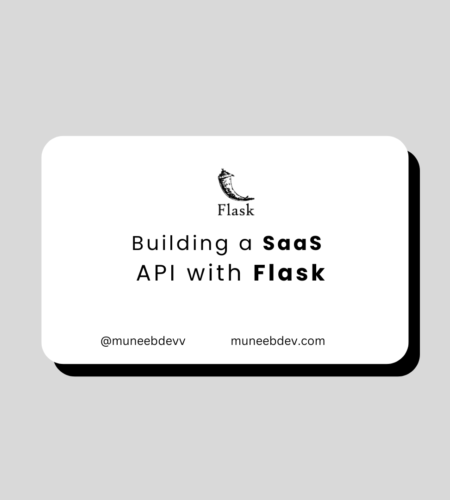Flask, a lightweight and flexible Python web framework, is perfect for building scalable RESTful APIs, making it an ideal choice for developing a SaaS (Software as a Service) API. This guide walks through setting up a Flask-based API, covering everything from installation to deployment.
Prerequisites
Before starting, make sure you have the following:
- Python 3.7+ installed.
- pip (Python package installer).
- A text editor or IDE (like VSCode or PyCharm).
- Basic knowledge of Python and Flask.
Step 1: Set Up the Environment
1. Create a Virtual Environment
It’s a best practice to work within a virtual environment to keep dependencies isolated:
mkdir flask_saas_api
cd flask_saas_api
python3 -m venv venv
source venv/bin/activate
2. Install Flask and Required Libraries
Install Flask and other necessary packages:
pip install Flask Flask-RESTful Flask-SQLAlchemy
Step 2: Project Structure
Organize your project with the following structure:
flask_saas_api/
│
├── app/
│ ├── __init__.py
│ ├── models.py
│ ├── routes.py
│ └── config.py
│
├── run.py
└── venv/
Step 3: Initialize Flask App
Edit app/__init__.py to set up the Flask application and database:
from flask import Flask
from flask_sqlalchemy import SQLAlchemy
db = SQLAlchemy()
def create_app(config_name='config.Config'):
app = Flask(__name__)
app.config.from_object(config_name)
db.init_app(app)
# Register routes
from .routes import api_bp
app.register_blueprint(api_bp)
return app
Step 4: Configuration
Define configuration settings in app/config.py:
import os
class Config:
SECRET_KEY = os.environ.get('SECRET_KEY', 'your_secret_key')
SQLALCHEMY_DATABASE_URI = os.environ.get('DATABASE_URL', 'sqlite:///app.db')
SQLALCHEMY_TRACK_MODIFICATIONS = False
Step 5: Define Models
Create a simple model for a SaaS resource in app/models.py:
from . import db
class User(db.Model):
id = db.Column(db.Integer, primary_key=True)
name = db.Column(db.String(100), nullable=False)
email = db.Column(db.String(120), unique=True, nullable=False)
def to_dict(self):
return {"id": self.id, "name": self.name, "email": self.email}
Step 6: Define Routes
Set up the API routes in app/routes.py:
from flask import Blueprint, request, jsonify
from . import db
from .models import User
api_bp = Blueprint('api', __name__)
@api_bp.route('/users', methods=['GET'])
def get_users():
users = User.query.all()
return jsonify([user.to_dict() for user in users]), 200
@api_bp.route('/users', methods=['POST'])
def create_user():
data = request.get_json()
if not data or not data.get('name') or not data.get('email'):
return jsonify({"message": "Invalid input"}), 400
new_user = User(name=data['name'], email=data['email'])
db.session.add(new_user)
db.session.commit()
return jsonify(new_user.to_dict()), 201
@api_bp.route('/users/<int:user_id>', methods=['GET'])
def get_user(user_id):
user = User.query.get_or_404(user_id)
return jsonify(user.to_dict()), 200
@api_bp.route('/users/<int:user_id>', methods=['PUT'])
def update_user(user_id):
user = User.query.get_or_404(user_id)
data = request.get_json()
user.name = data.get('name', user.name)
user.email = data.get('email', user.email)
db.session.commit()
return jsonify(user.to_dict()), 200
@api_bp.route('/users/<int:user_id>', methods=['DELETE'])
def delete_user(user_id):
user = User.query.get_or_404(user_id)
db.session.delete(user)
db.session.commit()
return jsonify({"message": "User deleted"}), 204
Step 7: Create Database and Migrate
Create the database and the initial tables:
flask shell
>>> from app import db, create_app
>>> db.create_all(app=create_app())
Step 8: Run the Application
Edit run.py to run the Flask app:
from app import create_app
app = create_app()
if __name__ == '__main__':
app.run(debug=True)
Start the server:
python run.py
The API will now be running at http://localhost:5000.
Step 9: Testing the API
Use tools like Postman or cURL to test your endpoints:
1. Get All Users
curl http://localhost:5000/users
2. Create a New User
curl -X POST -H "Content-Type: application/json" -d '{"name": "John Doe", "email": "john@example.com"}' http://localhost:5000/users
3. Get a Specific User
curl http://localhost:5000/users/1
4. Update a User
curl -X PUT -H "Content-Type: application/json" -d '{"name": "Jane Doe"}' http://localhost:5000/users/1
5. Delete a User
curl -X DELETE http://localhost:5000/users/1
Step 10: Deploying Your SaaS API
To deploy your Flask SaaS API, you can use services like Heroku, AWS, or DigitalOcean. Here’s how to deploy with Heroku:
1. Create a Procfile:
web: gunicorn run:app
2. Install Gunicorn:
pip install gunicorn
3. Commit Changes and Push to Heroku:
git init
git add .
git commit -m "Initial commit"
heroku create your-app-name
git push heroku master
4. Run Database Migrations on Heroku:
heroku run flask shell
>>> from app import db
>>> db.create_all()
Step 11: Adding Authentication (Optional)
For a SaaS API, you may want to secure your API using JWT (JSON Web Tokens) for user authentication. Install Flask-JWT-Extended:
pip install Flask-JWT-Extended
Update your routes to require authentication. Here’s an example of adding JWT-based login and protected routes:
from flask_jwt_extended import JWTManager, create_access_token, jwt_required, get_jwt_identity
def create_app(config_name='config.Config'):
app = Flask(__name__)
app.config.from_object(config_name)
db.init_app(app)
jwt = JWTManager(app)
from .routes import api_bp
app.register_blueprint(api_bp)
return app
@api_bp.route('/login', methods=['POST'])
def login():
data = request.get_json()
user = User.query.filter_by(email=data.get('email')).first()
if user and user.check_password(data.get('password')):
token = create_access_token(identity=user.id)
return jsonify({'token': token}), 200
return jsonify({'message': 'Invalid credentials'}), 401
@api_bp.route('/protected', methods=['GET'])
@jwt_required()
def protected():
user_id = get_jwt_identity()
user = User.query.get_or_404(user_id)
return jsonify({"message": f"Hello, {user.name}!"}), 200
Conclusion
Congratulations! You’ve built a simple yet functional SaaS API using Flask. Your API can:
- Handle CRUD operations for users.
- Utilize SQLAlchemy for ORM.
- Be secured using JWT authentication.
- Be easily deployed on platforms like Heroku.
From here, you can expand the API with additional features like:
- More detailed error handling.
- Rate limiting and API versioning.
- Adding more complex data models and relationships.
This guide gives you a strong foundation to build on as your SaaS API grows and scales. Happy coding!


Comments